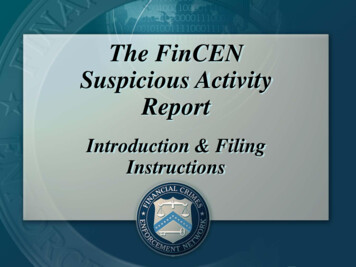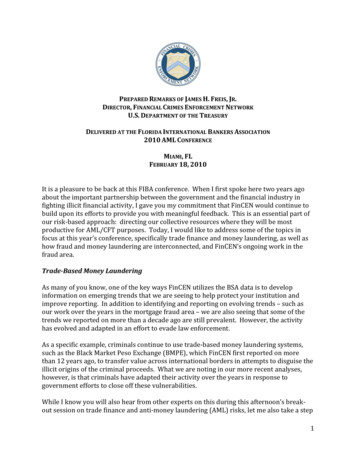
Transcription
The FinCENSuspicious ActivityReportIntroduction & FilingInstructions
Agenda Introduction The New FinCEN SAR: General Information Features and Advantages of the FinCEN SAR Filing Instructions: How to File the FinCEN SAR Frequently Asked Questions2
Introduction This webinar is presented by the collaborativeefforts of FinCEN’s Office of Outreach Resourcesand Office of Regulatory Policy and the Office ofCompliance. The purpose of this webinar is to provide thepublic with information and guidance regarding thenew FinCEN SAR.3
Agenda Introduction The New FinCEN SAR: General Information Features and Advantages of the FinCEN SAR Filing Instructions: How to File the New FinCEN SAR Frequently Asked Questions4
The New FinCEN SARGeneral Information It is a uniform report that can be used across multipleindustries to report suspicious activity. It was structured to be more intuitive and user friendly, The sequence of sections was revised. It has new fields to provide law enforcement withadditional information and support, Extended suspicious activity characterization list.5
The New FinCEN SARGeneral Information Beginning April 1, 2013, the new FinCEN reportsmust be used. Legacy versions of reports may not be uploadedinto the E-Filing system after March 31, 2013. Filers should consider creating new templates. Only available through the BSA E-Filing System. Reports may not be submitted in paper format.6
Agenda Introduction The New FinCEN SAR: General Information Features and Advantages of the FinCEN SAR Filing Instructions: How to File the New FinCEN SAR Frequently Asked Questions7
Features and Advantages ofthe FinCEN SAR FinCEN created the new SAR as a uniform reportthat can be used by any type of financial institution. Reports have been restructured to position thedifferent SAR Parts in a sequence that creates amore user friendly interface.8
Features and Advantages ofthe FinCEN SAR The FinCEN SAR features the sequence: Step 1: Part IV – Filing Institution Contact Information Step 2: Part III – Information about the FinancialInstitution where the Activity Occurred Step 3: Part I – Subject Information Step 4: Part II – Suspicious Activity Information Step 5: Part V – Narrative9
Features and Advantages ofthe FinCEN SAR The FinCEN SAR features the ability to addmultiple data elements including but not limited toSubject Information, Account Numbers, andInformation about where the Suspicious ActivityOccurred Part III may be auto-populated with the simplepush of a button10
Features and Advantages ofthe FinCEN SAR Suspicious Activity Characterization Industry driven; Revised to include additional types of suspiciousactivity; More than one box may be checked.11
Features and Advantages ofthe FinCEN SAR Filing Instructions FinCEN has clarified and expanded the SAR filinginstructions to be interactive and field specific. A user is now able to place the mouse cursor overany field for the instructions to become visible andobtain detailed information about how to completeany particular field.12
Features and Advantages ofthe FinCEN SAR Critical Fields Critical fields are those minimally required datafields necessary for the processing of the report bythe BSA E-Filing System. Critical fields are easily recognizable by their yellowbackground and asterisk.13
Features and Advantages ofthe FinCEN SAR Critical Fields Now feature an “Unknown” box. Users will no longerhave to enter responses such as “unknown”, “notapplicable”, “Not Applicable”, or “XX” in critical fields. The “Unknown” box can be checked when theinformation is not known or unavailable. Non-critical fields may be left blank when theinformation is not known or unavailable.14
Features and Advantages ofthe FinCEN SAR Critical Fields The BSA E-Filing System will not accept filingswhen critical fields are left blank.15
Features and Advantages ofthe FinCEN SAR Attachments Filers are now able to attach .csv files, which aresuitable for documenting transaction records that aretoo numerous to record in Part V. The attachments are not a substitute for thenarrative. Confidentiality rules apply to attachments.16
Agenda Introduction The New FinCEN SAR: General Information Features and Advantages of the FinCEN SAR Filing Instructions: How to File the New FinCENSAR Frequently Asked Questions17
18
Getting Started19
Getting Started When uploading a previously saved report orutilizing a template, click on “Open Existing Form”20
Getting Started When completing a discrete filing or settingup a template for the first time, select “Open NewForm”21
22
Step One:Filing Institution Contact Information23
24
25
26
27
28
Financial InstitutionIdentification The options listed in Item 84 aredescribed as follows: Central Registration Depository (CRD) number: Is thecentral licensing and registration system for the U.S. securitiesindustry and its regulators (used by FINRA and other securitiesregulatory bodies). Investment Adviser Registration Depository (IARD)number: The IARD and its system collect and maintain theregistration, reporting and disclosure information for InvestmentAdvisers and their associated persons. National Futures Association (NFA) number: The NFA is theindustry-wide, self-regulatory organization for the U.S. futuresindustry.29
Financial InstitutionIdentification The options listed in Item 84 aredescribed as follows: Research, Statistics, Supervision and Discount (RSSD) number:The National Information Center (NIC) is a central repository of dataabout banks and other institutions for which the Federal Reserve has asupervisory, regulatory, or research interest, including both domesticand foreign banking organizations operating in the United States. TheRSSD is a unique identifying number assigned by the Federal Reservefor all financial institutions, main offices, as well as branches. If “RSSD” is selected, but the identifying number is unknown, theinformation can be accessed at the Federal Financial InstitutionsExamination Council (FFIEC) Web Site athttp://www.ffiec.gov/find/callreportsub.htm.30
Financial InstitutionIdentification The options listed in Item 84 aredescribed as follows: Securities and Exchange Commission(SEC) number: Issued to individuals and entitiesregistered with the Securities and ExchangeCommission.31
32
Law Enforcement Contact Provide law enforcement contact information33
Step Two:Information about FinancialInstitution Where Activity Occurred34
35
Branch Activity If the suspicious activity occurred at a branchor an office complete this section of Step 2 Selling Location Paying Location Both36
Step Three:Subject Information37
38
39
Step Four:Suspicious Activity Information40
Suspicious ActivityInformation Dollar amount and date range of activity Amount involved in this report Date or date range of suspicious activity Cumulative amount for continuing activity reports41
Suspicious ActivityInformation Characterizations of Suspicious Activity Use the activity category items 29 through 38 torecord the types of suspicious activity being reported;check all boxes that apply. If a category applies but none of the options withinthe category apply, select that category’s “other” boxand briefly describe the type of suspicious activity inthe associated text field.42
Characterization ofSuspicious Activity Examples:43
Characterization ofSuspicious Activity44
Step Five:Narrative45
The SAR NarrativeThe narrative section of the report is critical tounderstanding the nature and circumstances of thesuspicious activity. The care with which thenarrative is completed may determine whether thedescribed activity and its possible criminal natureare clearly understood by investigators.46
The SAR Narrative The ability to add an attachment to the SAR wasimplemented. Because the ability to add an attachment to thenew FinCEN SAR was implemented, the number ofcharacters that may be entered into the narrativesection has been changed. The attachment is not a substitute for the narrativeitself.47
Agenda Introduction The New FinCEN SAR: General Information Features and Advantages of the FinCEN SAR Filing Instructions: How to File the New FinCEN SAR Frequently Asked Questions48
Frequently Asked QuestionsQ: Are items without an asterisk required to becompleted?A: Items with an asterisk, or items with yellow shading,are critical fields that the filer is required to complete. Ifan item does not have an asterisk, it is not a critical field.However, financial institutions should file all FinCENreports with complete and accurate information. Aspreviously noted, if the information is unknown for acritical field, the filer must check the associated“unknown” box or the report cannot be submitted toFinCEN.49
Frequently Asked QuestionsQ: How do I use the NAICS code field (Item 7a)?A: Select the option that best identifies the occupation ortype of business entered in Item 7. Filers can accessthe FinCEN approved list of NAICS codes from the dropdown menu in the FinCEN SAR. If no selection from theNAICS code list is appropriate, use a specific descriptiveword or phrase, such as “Carpenter” or “RetiredCarpenter” in the Occupation field, and leave the NAICScode field blank. Remember that simply entering“Retired” is not an adequate entry in this field.50
Frequently Asked QuestionsQ: How do I use the Paying and Selling Locationoptions (Item 64)?A: Check the box “Selling Location” if the branch soldthe products or instruments recorded in Items 39 or 40to a customer. Check the box “Paying Location” if acustomer received payment from the branch for theproducts or instruments recorded in Items 39 or 40.Check the box “Both” if the branch was both a payingand selling location for the products or instrumentsrecorded in Items 39 or 40.51
Frequently Asked QuestionsQ: How do I use the Paying and SellingLocation options (Item 64)?Example 1:If a customer purchases a monetary instrument from afinancial institution, then the financial institution has becomethe selling location. The filer would check the “SellingLocation” box.Example 2:If a customer redeems or cashes a monetary instrument, thenthe financial institution where the monetary instrument wascashed would become the paying location. The filer wouldcheck the “Paying Location” box.52
Frequently Asked QuestionsQ: Where can I find the Technical Specifications andline item Filing Instructions for the new FinCENSAR?A: Technical Specifications and line item FilingInstructions may be found in Attachment C located ARElectronicFilingRequirements.pdf53
Frequently Asked QuestionsQ: Can I access copies of previously filed reportsthrough the BSA E-Filing SystemA: The BSA E-Filing System is not a record keepingprogram; consequently, filers are not able to access orview previously filed reports. The BSA E-Filing systemdoes, however, provide tracking information on pastreport submissions.54
Frequently Asked QuestionsQ: What is an internal control number/file number(Item 91)?A: In an effort to avoid potential disclosure of a SAR,financial institutions may assign a unique internalcontrol/file number to each report, which lawenforcement or regulatory agencies can referencewithout disclosing the existence or content of a particularSAR.55
For More InformationThe BSA Regulatory Helpline1-800-949-2732BSA Resource Center@fincen.govBSA E-Filing Help Desk1-866-346-9478BSAEFilingHelp@fincen.gov56
Q: How do I use the Paying and Selling Location options (Item 64)? A: Check the box “Selling Location” if the branch sold the products or instruments recorded in Items 39 or 40 to a customer. Check the box “Paying Location” if a customer received payment from the branch fo










